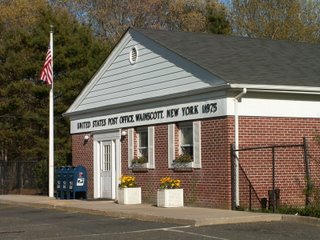
Tuesday, October 10, 2006
The Daily Hump: I've got wood...
 ...wainscotting, that is. For those of you who aren't involved in home decorating wainscotting is either the panel (usually wood) that's applied to walls of rooms or it's the lower part of a wall when its finish is different than the upper portion. Although now mainly decorative, its original purpose was to cover the lower part of walls which were often subjected to rising dampness. In more general terms wainscot is a high quality type of oak imported from either Russia, Germany or the Netherlands.
...wainscotting, that is. For those of you who aren't involved in home decorating wainscotting is either the panel (usually wood) that's applied to walls of rooms or it's the lower part of a wall when its finish is different than the upper portion. Although now mainly decorative, its original purpose was to cover the lower part of walls which were often subjected to rising dampness. In more general terms wainscot is a high quality type of oak imported from either Russia, Germany or the Netherlands. Marge Simpson: This house has such beautiful wainscotting.Marge is right. Per the American Heritage Dictionary wainscot is a Middle English word from the Middle Dutch waghenscot. It's likely that waghen- is related to the Dutch wagen or our word wagon as wainscot may have referred to the quality of wood used in carriage construction. The suffix -scot simply means "partition".
Mrs. Quimby: Marge, I didn't know you were into wainscotting.
Marge: I read an article about it at the tire store. Did you know it's not named after someone named Wayne Scott?
Woah...hold your horses there, American Heritage. The OED isn't too quick to define -scot as partition. In fact, it doesn't at all--simply saying the ending has an "uncertain meaning". Even the the waghen- portion is up for debate with a 16th century source saying the word is from the Flemish waeghe, wave, referring to the undulations in the grain of the wood. Some modern scholars suspect the prefix comes from the Middle Dutch weeg, wall. The OED stands by its contention that wain- really is from wagon- although it admits the original meaning of the compound word is a mystery.
It's interesting to note that there is a word wain that appears in Middle English and up through dialectal Modern English meaning a large open vehicle, such as a wagon. Both wain and wagon can be traced back to the Indogermanic root *wegh- or *wogh- meaning "to carry". This root also gives us modern words of common usage such as weigh and way.
For you Hamptons folks, you've likely blinked and missed the hamlet of Wainscott (note: two t's--population 628) while heading out to your Amagansett house. In researching the etymology I uncovered this from Newsday.com:
Four years after East Hampton Town was founded in 1648, the first mention of the rich soil of Wainscott occurs in official records, citing an order that "a cartway shall be laid out to Wainscott where it may be most convenient.''
 Wainscott post office: note lack of wainscotting
Wainscott post office: note lack of wainscottingGiven the OED's definition of wain is it possible that Wainscott received its name because of this "cartway"? That'd be cool, but no. Per Wikipedia the hamlet was named after a village north of Maidstone, England.
Labels: Middle Dutch, Middle English, PIE, The Daily Hump
:: posted by David, 8:12 AM